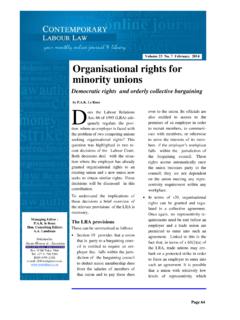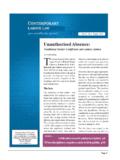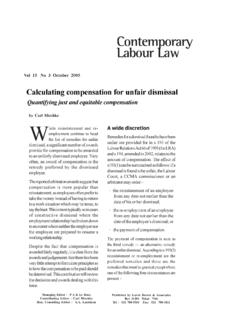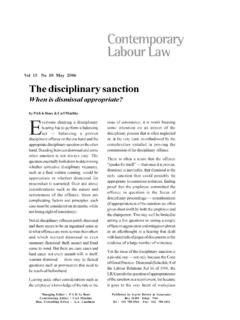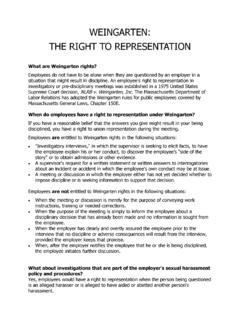Transcription of What constitutes insubordination? - workplace.co.za
1 Vol. 22 No. 10 May 2013. what constitutes insubordination ? The Supreme Court of Appeal decides one example by le Roux T. he recent decision of the Supreme candidates for the post of Chief Court of Appeal in National Operations Officer. In the letter they Union of Public Service & Allied indicated that they would not Workers Union obo Mani and Nine recognise the person so appointed, Others v National Lotteries Board would not co-operate with or assist (576/12) [2013] ZASCA 63 (24 May 2013) him or her and would isolate the deals with disciplinary action on the grounds appointee.
2 Of insubordination in the context where the The Human Resources Manager employees had lodged a petition against their responded in a letter in which he CEO. indicated that the Union was not entitled It provides important guidance as to what to peruse the CEO's contract and constitutes insubordination . This, together pointed out that the employees were with the fact that it is a decision of the entitled to use the employer's grievance Supreme Court of Appeal makes it of procedure. In a separate letter more than passing interest.
3 Addressed to the Union the Human Resources Manager also indicated that The facts its representatives had no right to attend Various employees employed by the the interviews of candidates for the employer in this matter were unhappy with the leadership style of the CEO of the In this organisation. This led to three shop stewards writing two letters, on the letterhead of their Union, to the organisation's Human what constitutes Resources Manager. In the first they "incitment"? p95. complained about the leadership style and Testnig modus operandi of the CEO and indicated the they were no longer prepared to bear is Interpreting the fariness Managing Editor: Le Roux Editor: style of leadership.
4 They also demanded Basic Conditions of of Published by Gavin Brown & Associates that they be permitted inspect the CEO's Employment Act po rmoitns Box 31380 Tokai 7966. Tel: 021 788 5560 contract of employment. In the second letter p96 p46. they expressed their discontent in not being invited to attend the interviews of Page 91. Contemporary Labour Law Vol 22 No 10 May 2013. position of Chief Operations Officer. A breach of the duty to act in good faith. The Union then referred a dispute to the CCMA in The disciplinary hearing was chaired by an independent which it requested the CCMA to order the employer chairman.
5 The chairman found all the employees guilty to disclose the CEO's contract of employment. During of insubordination and disrespectful behaviour as well the conciliation process it was agreed that the as bringing the name of the employer into disrepute. conciliation process be extended in order to enable the In coming to the decision relating to insubordination Union to write to the Employer's board motivating why the chairperson accepted the definition of it should be entitled to see the contract. The Union insubordination provided by John Grogan in Dismissal, then addressed a letter dated 23 May 2008 to the Board Discrimination and Unfair Labour Practices (2nd ed in which it made certain defamatory allegations against 2007).
6 This is described as occurring - the CEO, a copy of which found its way into the when an employee refuses to accept the hands of the press. The CCMA eventually refused to authority of his or her employer or of a person grant an order requiring the Employer to disclose the in a position of authority over an employee.. contract of employment. During the course of concluding arguments at the On 3 June 2008 41 employees signed a petition in the disciplinary enquiry the CEO remarked that not all of form of a letter addressed to the Human Resources the employees may have realised the seriousness of Manager in which they expressed a vote of no their actions.
7 This prompted the chairman of the confidence in the CEO and urged the Board to ensure disciplinary enquiry to take a fairly unusual approach that 30 June 2008 would be the last day of his to the sanction to be applied. The employees were employment with the employer. It was also stated that, given an opportunity to sign a formal acknowledgement we are no longer prepared to spend a day and undertaking to the effect that: they disassociated with Professor Ram in the same building with themselves from the letter of 23 May 2008 and the him at the helm of this organisation.
8 Petition of 3 June 2008; they accepted their wrongdoing;. The employer's lawyers then addressed a letter to the they apologised to the CEO; they undertook to utilise Union in which the actions of the employees who signed the grievance procedures provided for in the employer's the petition was described as insubordination and the policies and provided for in the LRA; and, that they ultimatum that the CEO leave employment on 30 June agreed to the imposition of a final warning. 2008 was described as subversive of the integrity All but ten of the charged employees complied with and authority of the Board.
9 The letter required the 41 this alternative. These ten employees submitted a employees to withdraw the petition set out in their collective submission which fell short of the letter and to do so within a stated period. Three of the requirements set by the chairman. They were employees retracted their support for the letter. The dismissed. remaining employees failed to do so and 38 were charged with three disciplinary offences namely The ten dismissed employees challenged the fairness insubordination and disrespectful behaviour of their dismissals.
10 They argued that - arising from the allegations made in the The dismissals were automatically unfair letter dated 23 May 2008 and the statement by virtue of the provisions of s 187(1)(d) of that they were not prepared to work with the Labour Relations Act, 66 of 1995. the CEO. (LRA). This section provides that a Bringing the name and integrity of the CEO dismissal is automatically unfair if the and the Board into disrepute arising from reason for the dismissal is that the employee the allegations set out in the letter of 23 exercised a right conferred by the LRA or May 2008 and the petition, as well as the participated in any proceedings in terms of publication of the letter of 23 May 2008 in the LRA.

